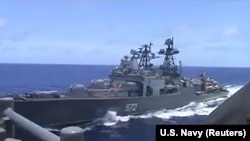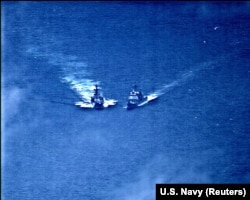On June 7, a Russian navy destroyer Admiral Vinogradov had a near miss incident with a U.S. navy warship, the U.S.S. Chancellorsville in the Western Pacific Ocean between Taiwan and Okinawa (the specific location of the incident is disputed by both sides).
The Russian state news agency TASS reported that Russian Navy had voiced a protest with U.S. naval command over the incident, and that the U.S. vessel had “impeded” the movement of the Russian vessel when it “suddenly changed its course.”
Meanwhile, the U.S. 7th Fleet released its own statement on the incident, which in part reads:
“While USS Chancellorsville was recovering its helicopter on a steady course and speed when the Russian ship DD572 maneuvered from behind and to the right of Chancellorsville accelerated and closed to an unsafe distance of approximately 50-100 feet.This unsafe action forced USS Chancellorsville to execute all engines back full and to maneuver to avoid collision.”
The 7th Fleet’s statement refers to the “International Regulations for Preventing Collisions at Sea,” (COLREGS) a Convention introduced in 1972, which entered into force in 1976, and to which the UN member states, including the U.S. and Russia are signatory. Rule 3/IV of the Regulations define a vessel engaging in launching or recovering aircraft as “vessel restricted in her ability to maneuver,” and “therefore unable to keep out of the way of another vessel.”
The rules stipulate that other vessels should keep out of the way of the vessels, which are restricted in their ability to maneuver. This would describe the U.S.S. Chancellorsville, if and when, as the 7th Fleet’s statement claims, it was in the process of recovering its helicopter. Special flags were flown to make it clear the vessel was engaged in this task.
The statement that the Chancellorsville was engaged in recovering its aircraft may be further supported by a photograph of the event published by the U.S. Navy. It is apparently taken by an aircraft flying ahead of the two vessels, though it is not entirely clear whether this was taken by the Chancellorsville’s helicopter or another aircraft, possibly a drone. Polygraph.info reached out to the U.S. Navy for confirmation on the origins of the photo, but the Navy has not responded at this time.
The photo does provide some helpful clues, however. For example, a ship’s speed and direction can be estimated based on the wake it creates as it cuts through the water. In the photo, the Admiral Vinogradov’s wake is noticeably larger than the Chancellorsville’s, indicating that the former is traveling at a higher speed. The wake pattern behind the Russian ship curves, suggesting a change of direction, while the American ship’s wake pattern is straighter.
The 7th Fleet’s statement indicates that the Russian vessel “maneuvered from behind.” It says, the Admiral Vinogradov was approaching on “the right of Chancellorsville,” and that it also “accelerated and closed to an unsafe distance.”
Rule 15 of the COLREGS states: “When two power-driven vessels are crossing so as to involve risk of collision, the vessel which has the other on her own starboard side shall keep out of the way and shall, if the circumstances of the case admit, avoid crossing ahead of the other vessel.”
These details are essential, since they show that the Russian vessel acted in violation of multiple COLREGS regulations, including Rules 3; 5; 6; 7 and 8.
The video footage of the incident released by the U.S. navy confirms these details, making the U.S. navy account of the events verifiable, while the Russian navy has not shared any digital verification of its claim.
Limited access to the information, due to its military nature is an obstacle to determining the exact course of events that took place on June 7. However, the statement from the U.S. Navy describes the conditions regulated under the COLREGS rules for vessels recovering aircraft. Such vessels must maintain a constant course and speed, as well as display proper signals showing restricted ability to maneuver. In such a case, in accordance with the COLREGS regulations, the Russian Admiral Vinogradov was responsible for giving a safe passage.
Based on these findings, the Russian fleet’s claim that the Chancellorsville abruptly changed course and impeded the movement of the Russian destroyer is likely false.






